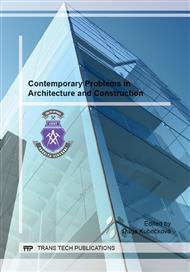p.60
p.66
p.71
p.76
p.80
p.86
p.92
p.98
p.113
Study on Effect of Performance of Recycled Aggregate Concrete with Secondary Manufacturing Shell Mixing Approach
Abstract:
The application of recycled aggregate concrete (RAC) has environmental benefits, social benefits and economic benefits, which has profound significance to the sustainable development of society. However, recycled aggregate (RA) has a large porosity, high water absorption, high crush index, etc. In addition, the interface transition zone (ITZ) is the weak link of RAC, which has limited the application of RAC. Based on the advance of RAC, by discussing the characteristic of the ITZ of RAC, this paper proposes a secondary manufacturing shell mixing approach (SMSMA), and the mechanism of this mixing approach and its effect on performance of RAC are analyzed. Compared with the test of normal mixing approach (NMA), it indicates that compressive strength and splitting tensile strength of RAC through SMSMA are generally increased by about 10% ~ 25% and 10% ~ 40% at 28 days respectively, and the chloride ion diffusion coefficient are generally declined by about 10% ~ 15% at 28 days, but the liquidity of RAC is not improved. What's more, with replacement rate of RA dropping, the improvement of the performance of RAC tends to be better.
Info:
Periodical:
Pages:
80-85
Citation:
Online since:
October 2014
Authors:
Price:
Сopyright:
© 2014 Trans Tech Publications Ltd. All Rights Reserved
Share:
Citation:


